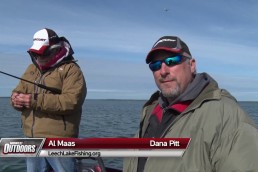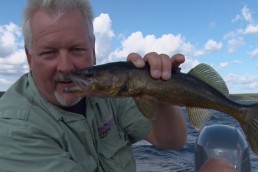Spinner Fishing 101 for Leech Lake Walleyes
SHARE THIS POST
As the spring fishing is now segueing to early summer on Leech, a different pattern is emerging. Fish are coming out of the shallow, sandy spawning areas, have devoured schools of spottails and are going in search of a main ingredient of walleye “gumbo”—the crayfish.
While crayfish can be found in a lot of places on Leech, one of the best is the system of rock bars and reefs out on the main lake. In order to efficiently and effectively pluck them from these rocks, you need to utilize spinners. Spinners allow you to cover water effectively.
The rod and reel
Before you even buy a spinner, one of the most important things is to make sure you have the right rod, reel and fishing line set up. Personally, I prefer the telescoping rods. As a guide, it’s all about maximizing space, and with a telescopic rod I can take advantage of the length, yet have it fit in my rod lockers. Tournament pro, Toby Kvalevog, has been fishing spinners in tournaments all over the Midwest. He has also been a guide for the last 20-plus years. Kvalevog likes to employ trolling rods that are a bit longer than is average.
“With the new, longer trolling rods out there, it gives the fisherman a distinct advantage when trying to get the spinners out away from the boat,” Kvalevog says.
He added this is especially effective when fishing shallower water where you may spook fish, and that it also allows you to not have to worry about using cumbersome planer boards. The main rock areas on Leech are 15 fish or less, and it can be easy to spook fish on the calm days. Line-counter reels paired with 10-pound-test monofilament can also help you dial in when gauging how far out the baits are running.
Are you enjoying this post?
You can be among the first to get the latest info on where to go, what to use and how to use it!
So many blades, so little time
There are many spinners on the market today—where does a walleye fisherman start? Paramount to any effective trolling program is to find a spinner that has high-quality components from the swivel down to the hook. Many of the spinners today have fairly short snells. When fishing a lake like Leech, being able to have spinners that have snells at 6 to 10 feet can be key in putting fish in the boat consistently. The added length and longer rod is helpful when fishing shallow. Another consideration is the size and color of the blades. Standard spinners will come with Colorado blades in sizes 3, 4 and 5. The size is a key component for the speed at which you troll the spinners. Larger sizes, such as a 5, mean you will need to increase speed to keep it off the bottom and put off a larger flash and vibration in the water. Smaller sizes allow you to troll slower and offer a finesse approach. In terms of color, think “match the hatch,” since they are chasing crayfish (aka walleye “gumbo”). Shades of orange are ideal. Combine the blades with quality hooks and you have a spinner that can stand the test of numerous walleye hook-ups.
What bar?
No, not the bar with stools and cold pops; I am talking about rock bars on Leech Lake, Annex, Submarine, North Bar and Mokey reefs. The reality is they all hold fish at different times or will have biters at different parts of the day. However, no matter where you start, try this: Begin your search on the side the wind is blowing into because more times than not, that’s where they’ll be hanging out. Cruise the structure, and as you move along, set waypoints to create a trolling pattern and then chart a course to attack these fish. Once you have your waypoints set, deploy your spinners into the depths and begin trolling. The speed at which you troll the spinners will be dictated by the mood of the fish. Often, between .8 and 1.2 mph is a good start. When you do hook-up, note depth and speed. Optimally, you are using your bow-mount trolling motor for a more stealthy approach. However, the main lake on Leech can get a little bumpy, and you may need to combine your big motor and bow-mount to get the job done.
I am there, I am ready—now what? Too many want to overthink spinners and their ego gets in the way by demanding to hold the rod. People will disagree with me and that is fine. However, if you want to put more fish in the boat, don’t hold the rod. No, that is not a typo; I said don’t hold the rod. Get it to the depth you need and let it be. The monofilament and the longer rod will set the hook for you. When you get bit, be patient and let the rod load, gently lift the rod out of the holder and begin reeling. Overthink it if you want, but keeping it simple is the way to go.
Spinners and walleyes are have been fundamental for decades, whether it is the traditional red/white Colorado blade that was so popular or the new and improved spinners made today. With the right presentation, spinners can put a load of Leech Lake walleyes in the boat for you this summer.
MWO
SHARE THIS POST
Did you enjoy this post?
You can be among the first to get the latest info on where to go, what to use and how to use it!
Jim Ernster
Jim Ernster is a guide and pro staffer with Leisure Outdoor Adventures, a premier fishing guide service in Walker, Minn. Check them out at leisureoutdooradventures.com or call 855-562-4665.



